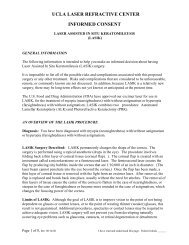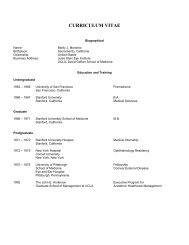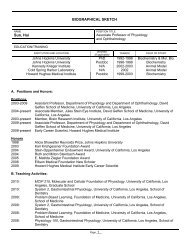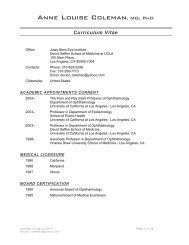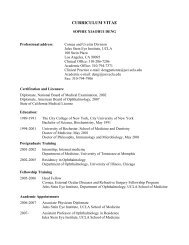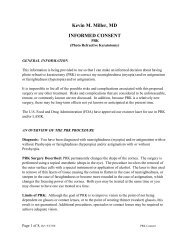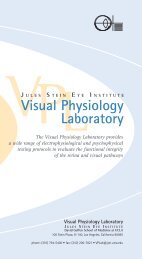View Annual Report - Jules Stein Eye Institute
View Annual Report - Jules Stein Eye Institute
View Annual Report - Jules Stein Eye Institute
You also want an ePaper? Increase the reach of your titles
YUMPU automatically turns print PDFs into web optimized ePapers that Google loves.
UCLA Center for <strong>Eye</strong> Epidemiology<br />
The UCLA Center for <strong>Eye</strong> Epidemiology, under the<br />
direction of Dr. Anne L. Coleman, was established in<br />
1998 to promote interdisciplinary investigations into<br />
blinding diseases of public health importance. It is<br />
supported by private donations including an endowment<br />
established by The Ahmanson Foundation. The Center<br />
maintains and improves vision health through public<br />
health research and intervention, and serves as a<br />
coordinating body for expanding and sharing information.<br />
Center members have expertise in epidemiology, bio-<br />
statistics, health policy, public health, and international<br />
health. Members draw on their diverse backgrounds and<br />
complementary skills to promote an understanding of<br />
issues related to vision health as it affects individuals,<br />
communities, and society. The Center encourages<br />
collaborative research among faculty and investigators<br />
from various UCLA departments and other institutions<br />
around the world to advance knowledge related to the<br />
causes and prevention of specific eye diseases.<br />
Center to Prevent Childhood Blindness<br />
The Center to Prevent Childhood Blindness, under<br />
the direction of Dr. Sherwin J. Isenberg, is com-<br />
mitted to reducing pediatric blindness. UCLA physi-<br />
cians and basic scientists, including Drs. Leonard Apt<br />
(co-director) , Gary N. Holland, Steven Nusinowitz, and<br />
Irwin Weiss, collaborate on research, education, and<br />
patient care programs designed to increase awareness<br />
and help treat pediatric blindness. Significant emphasis<br />
is on the development and evaluation of ophthalmic<br />
medical and surgical options for children.<br />
Center members are developing a new noninvasive<br />
method of measuring blood gases from the surface of<br />
the eye, which may be critical in preventing retinopathy<br />
of prematurity, a leading cause of blindness in premature<br />
newborns. In another avenue of research, the<br />
Center developed a very inexpensive antiseptic solution<br />
to treat pediatric corneal infections in underdeveloped<br />
areas, and completed a study showing its effective-<br />
ness in treating corneal ulcers that now blind more<br />
than 400,000 children worldwide. A second study,<br />
which evaluated the solution’s effectiveness in treating<br />
fungal corneal infections, a major cause of pediatric<br />
blindness in tropical countries, is now undergoing<br />
statistical evaluation.<br />
80 Programs | Research and Treatment Centers<br />
Clinical Research Center<br />
The <strong>Jules</strong> <strong>Stein</strong> <strong>Eye</strong> <strong>Institute</strong>’s Clinical Research Center<br />
(CRC) was established in 1998, to provide core support<br />
to faculty members who are conducting patient-based<br />
research studies. This support involves vital, behind-thescenes<br />
activities that facilitate the clinical research<br />
process. Dr. Gary N. Holland serves as director of the<br />
CRC; additional members of the Board of Directors<br />
include Drs. Joseph Caprioli, Michael B. Gorin,<br />
Ralph D. Levinson, and Steven D. Schwartz. The CRC<br />
has a full-time administrator, Ms. Ellen Haupt, and an<br />
in-house statistician, Dr. Fei Yu. CRC staff members<br />
interact with granting agencies and government<br />
regulatory bodies; assist with the preparation of grant<br />
applications; participate in the design and management<br />
of clinical studies; and perform data collection and<br />
analysis functions.<br />
<strong>Institute</strong> faculty members are currently conducting<br />
more than 60 clinical research studies (listed in the<br />
Appendices). Patients can volunteer to participate in<br />
studies that contribute to a better understanding of<br />
ocular disorders or that evaluate new, potentially better<br />
treatments for various diseases of the eye.<br />
Contact Lens Center<br />
The Contact Lens Center, under the direction of<br />
Dr. Barry A. Weissman, was created through a reorganization<br />
of the contact lens service in 2002 to provide<br />
patients with an expanded treatment program and<br />
facilities. The Center serves patients with all ophthalmic<br />
diagnoses that can be treated with contact lenses,<br />
including nearsightedness and farsightedness, regular<br />
and irregular astigmatism, and presbyopia. The Center<br />
also treats patients who have had eye diseases that are<br />
only optically or therapeutically approached with contact<br />
lenses (eg, aphakia, keratoconus, post-corneal transplants,<br />
corneal trauma, and infection).<br />
The Center is one of several across the nation that<br />
participated in the landmark Collaborative Longitudinal<br />
Evaluation of Keratoconus (CLEK) Study sponsored<br />
by the National <strong>Eye</strong> <strong>Institute</strong>. Other research conducted<br />
by faculty at the Center includes contact lens wear<br />
complications, such as neovascularization, abrasion, and<br />
corneal infection; and systems of oxygen supply to the<br />
corneas of contact lens wearers.




